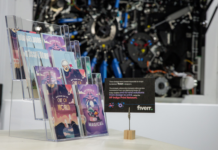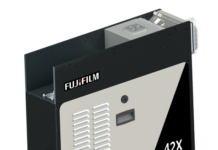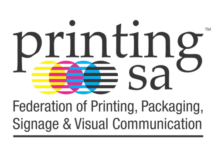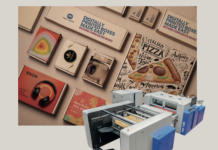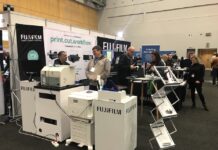The industrial inkjet market, a sector I’ve worked in for 30 years, is gaining ground rapidly but is it answering the shifting demands of the printing industry? There is no doubt that there are considerable opportunities for growth, particularly in digital labels and packaging. This article appears in the Africa Print Journal.
A digital economy suggests variation and customisation, and this is where digital printing, and particularly inkjet, makes economic sense. But any high volume non-variable print will remain with conventional analogue print technologies, simply because digital print costs more. In a digital economy, late-stage customisation becomes a very real need. Where everything is customised your mobile phone, your clothing, your medicine then the ability to print economically directly onto the finished product just before shipment is key. In our opinion, today’s label converters should consider becoming print solution providers to their customers. Perhaps this entails installing digital print units in their customer sites by printing directly onto items that once needed a label.
Packaging Requirements Become More Diverse
The packaging and labelling market remains an enticing prospect for commercial printers and is attracting forward-thinkers, but they must be careful in selecting the right equipment. The requirements for packaging are likely to be a lot more diverse than the markets they have been in until now. The packaging market is usually looking for special effects so a customer will want to choose a print system capable of more than just CMYK.
However, the good news for printers is that they don’t necessarily have to make a big investment, even at entry level, to make packaging work, be it in software, finishing kit or press adaptations, or, indeed, new staff. Many printers are finding that they can simply install an inkjet module onto an existing press, avoiding the need to invest in a completely new press. People who want to print on packaging at packaging line speeds won’t be using a wide format machine, which prints in terms of millimetres/minute, whereas commercial printers talk in terms of hundreds of metres/minute.
In single-pass printing, the addition of variable information using inkjet at high speed has been a reality for years. What is different is that modern inkjet systems are far more capable than the older systems. I mean in terms of quality, print width, low-migration inks, white, colour and special inks such as fluorescent security inks.
Special Effects Become The Norm
Exactly what a packaging client will expect of its commercial printer depends on their relationship. I’d again argue that a lot of special effects will become more of the norm. For example, this is true with varnishes – particularly tactile or 3D, and metallic effects, particularly gold. Here at Industrial Inkjet Ltd, which is an industrial inkjet specialist and the official sales and technical support centre for Konica Minolta products outside of Asia, we offer advice on any aspect of the use of inkjet technology in industrial applications, providing complete solutions for the successful design and implementation of Konica Minolta’s industrial print heads, which are renowned for high print quality and reliability.
We have meetings on-site virtually every day with customers and have built up a good understanding of what is important for each customer: what they will need to understand and what the problems will be.
Inkjet Technology Is Spreading Out
It’s our job to find out if digital print is really going to make sense for them. As well as the obvious print sample work, we spend a long time talking about how the inkjet system would need to fit into their production line. We talk about issues like pre-treatment of the material, ink adhesion, resolution and print quality as well as post-print curing of the ink.
What we think is now happening in inkjet technology is a rapid spread out into many different application areas. Thirty years ago ‘best before date’ regulations caused a rapid expansion of simple, ‘continuous’ inkjet printers that printed a low quality date code with smelly solvent inks. That market still exists but it’s very mature and stable. Nothing much changes. The same companies that were successful with date coding also introduced mechanical valvejet technology for outer-case coding. Typically this is very low resolution, big-drop print onto brown cardboard boxes. Again it’s simply applying a code, it’s not printing the full decoration onto the box.
So what has changed?
Fundamentally the change is that piezo inkjet technology has advanced. But perhaps, more importantly, inks for piezo inkjet have become hugely more capable, and the price has reduced. Suddenly the economics makes sense.
How has the piezo technology advanced? Well, little more than 10 years ago, quality and reliability were best described as ‘limited’. Drop sizes were too large for fine colours or details. But the key problem was reliability the dreaded ‘missing jet’ problem. If many nozzles in a print head go missing then you have to hide them and that means multi-pass print only. So back then piezo inkjet was limited to wide format machines. What changed is that the print head quality improved but also the understanding of how to use the print heads correctly has developed. Suddenly it became possible to guarantee that all jets in a printer would fire reliably for some hours. Not that they would fail and restart again, that simply causes bad yields, but that they would keep working.
Once you have reliable printing then single-pass in-line becomes possible. From there the trend is inevitably towards faster and wider one-pass print systems. Print widths have grown from 36mm to 1.2m or more. Speeds have grown from less than 20m to around 80 or 100m/minute. Monochrome or spot colour systems gave way to full process colour.
New Generation Of Inks
But coming back to ink, in the last 12 years we have gone from simple oil-based inks that would only work on absorbent card, through UV inks, to low migration UV-curable inks that are suitable for ‘accidental’ food contact, so suitable for use on the outside of a food bag or container. Now we are seeing new generations of inks that are completely ‘safe’ and could be used even, for example, on the plastic spoon that is supplied with your ice-cream. We are also seeing a lot more use of security inks, for brand protection or for track and trace. For example, there are IR-readable inks or ‘invisible’ inks that only fluoresce at a specific light frequency.
But we must not forget that no one will use inkjet in packaging unless the economics make sense. Two things have changed that impact the economics: ink price and the desire or need for variation. Taking the second point first: why has variation increased? It’s partly marketing and it’s partly regulation. The marketing aspect is fairly obvious.
We’ve all watched what Coca-Cola is doing with customising or personalising Diet Coke. While what’s been done may have seemed to be extreme at the time, the trend could take us much further. Perhaps we won’t get as far as ordering one coke bottle with your girlfriend’s photo on it but, for sure, regional variations in design will come, perhaps the bottles delivered to each city will feature photos of the local football stars?
The Question Of Regulations
Then there are regulations and Brexit. In Europe new rules came in about minimum font sizes on food packaging. Combine this with the need to have the nutrition information in the appropriate language and it means instead of two or even four languages on a package only one will now fit. This means product run lengths just reduced drastically, which means set-up costs for conventional printing just jumped.
And this is where the fall in inkjet ink price is helping. A few years ago the ‘street’ price for good quality UV-curable inkjet ink was perhaps R2283 (£135)/litre. Now it’s usually around R1268 (£75) and falling. And water-based inks might be half that price. But these prices are still several times those for ‘conventional’ inks.
For every customer’s project we have to calculate an accurate model, usually using the customer’s own image files. We need to compare the true cost/print for digital versus their production costs today. Basically it’s the higher inkjet ink cost versus the savings in setup time and product waste. The output from the calculation is usually a simple number: the break-even run length. Armed with this, and knowing where the demand for variation is going, the decision to invest in digital or not is very clear.
In summary, the technology to use inkjet throughout the packaging and printing industries is here. The important thing now is to keep a close eye on the improving economics.



